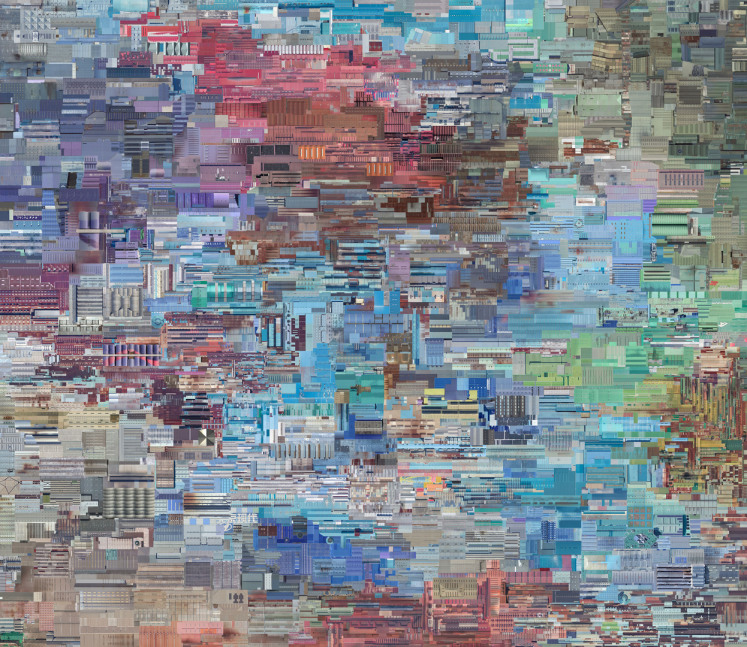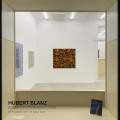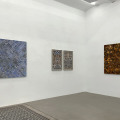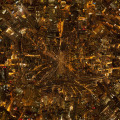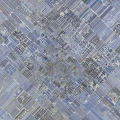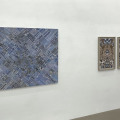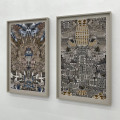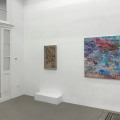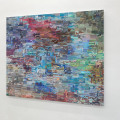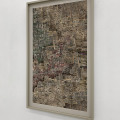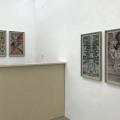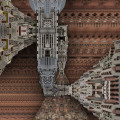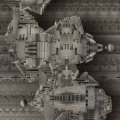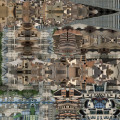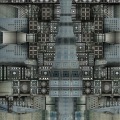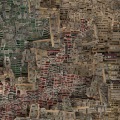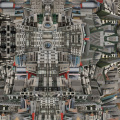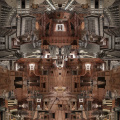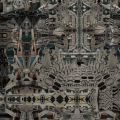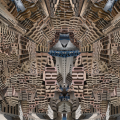Hubert Blanz. In Search Of Radiant Cities
Indem Hubert Blanz die Vielfalt von Autobahnen, Gerüstplanen auf Baustellen (Schwere Wolken, 2019), Aussichtsplattformen und
Flachdächern (The Fifth Face, 2010–2012), Gullideckeln (Industrial Scan – Wien, 2013) oder Kanalsystemen aus Kunststoffrohren (Industrial Scan – Rhizom, 2013–2015)
aufzeichnet, gewinnt er dem Alltäglichen ungeahnte Facetten ab. Den Kontext dafür bildet die Maschinerie der Großstadt, geprägt von Industrialisierung, Massenproduktion und Menschenmengen. Die
Konstruktion der Objekte zu vielschichtigen Netzwerken und labyrinthartigen Strukturen verweist auf die mitunter verborgenen Ordnungen, die der modernen Stadt zugrunde liegen und steht in
unmittelbarer Beziehung zu ihrer Dichte und Mannigfaltigkeit. Das Bild der Stadt, das Blanz zeichnet, ist ein Konglomerat überwältigender Materialität, ein lebendiges Ensemble historischer Schichten,
ein (ir)realer Ort und ein Synonym für die Unüberschaubarkeit der Welt.
In seiner jüngste Werkserie La Valeur de La Vie. Auf der Suche nach den strahlenden Städten (ab 2019) widmet sich Blanz den
Pariser Villes Nouvelles und Banlieues. Auch diese Recherche beeindruckt allein schon durch ihren Umfang von über 4000 Fotos, die während eines dreimonatigen Aufenthalts in Paris als Vorlagen für die
digitalen Fotocollagen entstanden sind. Von den Planstädten in der Peripherie hat Blanz bevorzugt jene Wohnsiedlungen ausgewählt, die nicht nur im Sinne der modernen Stadtplanung eine radikale
Setzung darstellen, sondern sich durch ihre postmoderne Ausprägung und ihren Wahrzeichen-Charakter auch deutlich von den funktionalen Bauten der 1960er- und 1970er-Jahre abheben. Zu den porträtierten
Objekten zählt etwa der 1984 fertiggestellte Wohnkomplex Les Espaces d’Abraxas des katalanischen Architekten Ricardo Bofill, eine monumentale, als „Versailles für das Volk“ konzipierte
Anlage, deren auf den Innenhof ausgerichtete Fassade mit ihren antikisierenden Säulen, Renaissance Tempietti aus Betonfertigteilen und verspiegelten Halbsäulen ebenso hochherrschaftlich wie absurd
und surrealistisch anmutet. Außerdem sei hier stellvertretend für die insgesamt fast 40 dokumentierten Gebäudeensembles noch Les Arènes de Picasso von Manuel Núñez genannt – ein ähnlich
theatralischer Ort, der vor allem wegen der zwei markanten Hochhausscheiben, die den zentralen achteckigen Platz einfassen und als Allegorie auf den Sonnenaufgang konzipiert wurden, bekannt
ist.
Heute sind die Planstädte größtenteils zu Ghettos und sozialen Brennpunkten mit hoher Arbeitslosigkeit und Kriminalität verkommen,
während sich die mit ihrem Bau verknüpften Vorstellungen vom besseren Leben zerschlagen haben. Blanz’ Aufmerksamkeit gilt allerdings weniger den konkreten Lebensbedingungen oder dem Scheitern der
sozialen Vision, als vielmehr dem futuristischen Potenzial und der Energie, die den gigantischen Wohnkomplexen nach wie vor innewohnen. Seine Collagen greifen die Ideen der Postmoderne, wie die
Vermischung der Stile, das Zurückgreifen auf historische Elemente und den ironisch-spielerischen Umgang mit bekannten Bauformen auf. Die Details der Gebäude, die er aus allen möglichen Perspektiven
fotografisch erfasst hat, werden zu Bausteinen für ornamentale Muster, die mit denselben Kompositionsprinzipien wie die Architektur spielen: Wiederholung und Spiegelung. Die fotografischen Vorlagen
werden gekippt, gedreht und ineinandergeschoben. Die geometrischen Komplexe und Territorien, die aus seinem fantasievollen Umgang mit den reproduzierten Oberflächen der Hausfassaden und Wandflächen
entstehen, erinnern an Stadtlandschaften in Computerspielen. Die konstruierten Bildräume sind komplexe Labyrinthe mit verschiedenen Ebenen, absurden, unendlichen Fluchten und einander
widersprechenden Perspektiven, in denen sich die Schwerkraft teilweise aufzulösen scheint. Ihre räumliche Einheit wird durch die Mittel der Montage konstant außer Kraft gesetzt. Wie bei einem
Kaleidoskop sind die Spezifika der Umgebung, aus der sie stammen, ihre Formen und Farben, in den einzelnen Fragmenten zwar noch gut zu erkennen, ihr Zusammenspiel entführt die Betrachter*innen jedoch
in andere, imaginäre Sphären. Die zuvor bereits für das Oeuvre von Blanz als typisch beschriebenen Ambivalenzen zwischen einem umfassend dokumentierten und zugleich keine Orientierung bietenden
Variantenreichtum und zwischen einer authentischen und gleichermaßen an die digitale Matrix gekoppelten Materialität sind auch hier gültig. Zusätzlich werden sie um eine weitere Ebene bereichert,
nämlich um die Ambivalenz zwischen der Faktizität der architektonischen Details und der Kreation einer Utopie. Utopie ist dabei im Sinne der wörtlichen Übersetzung des Begriffs aus dem Griechischen
als „kein Ort“ zu verstehen. Aus Versatzstücken der Wirklichkeit schafft Blanz neue Städte, die nirgendwo zu finden sind. Obwohl sie von dieser Erde sind, sind es unmögliche, fantastische Orte. Seine
Reise durch die Satellitenstädte changiert ebenso wie seine Reise auf den Spuren Darwins zwischen Realität und Virtualität. Einmal mehr wird deutlich, wie sehr seine Werke eine zeitgenössische
Welterfahrung, in der ein Wechsel zwischen realer und virtueller Welt kontinuierlich von einem Moment auf den anderen stattfindet und die Wahrnehmung der uns umgebenden Materialitäten nahtlos in die
der Computerwelten übergeht, in ihrer ganzen Widersprüchlichkeit verkörpern.
- Dr. Annette Südbeck, Kuratorin und Geschäftsführerin Secession (Ausschnitt Katalogtext) -
When Hubert Blanz records the variety of motorways, scaffold tarpaulins at construction sites (Schwere Wolken, 2019), observation decks and flat roofs
(The Fifth Face, 2010–2012), manhole covers (Industrial Scan – Wien, 2013) or sewage systems made of plastic tubing (Industrial Scan – Rhizom, 2013–2015), he takes pleasure
in unexpected facets of the everyday. The context for this is the city’s machinery coined by industrialization, mass production and the multiple of people. Constructing complex networks and
labyrinthine structures with the objects points to occasionally hidden systems on which the modern city is based, and is directly related to their frequency and diversity. The image of the city that
Blanz draws is a conglomerate of overwhelming materiality, a vivid ensemble of historical layers, an (un)real place, and a synonym for the complexity of the world.
In his most recent series of works, La Valeur de La Vie. In Search of Radiant Cities (since 2019), Blanz deals with Paris’s new cities (villes nouvelles) and banlieues. Again, due to
its sheer scope of more than 4,000 photos taken during a three-month stay in Paris as basis for digital photo collages, his research is striking. From the planned cities on the outskirts of Paris
Blanz has preferably chosen those housing complexes that constitute a radical setting not only in terms of modern urban planning, but which thanks to their postmodern characteristics and landmark
nature contrast strongly with the functional buildings of the 1960s and 1970s. Among the portrayed objects, for instance, is the residential complex Les Espaces d’Abraxas by the Catalan
architect Ricardo Bofill – a monumental building completed in 1984 and designed as “Versailles for the people”, whose façade facing the courtyard with its antique-like columns, Renaissance Tempietti
made of precast concrete components, and mirrored half-columns appears both noble and oddly surrealistic. In place of almost 40 featured ensembles of buildings, Les Arènes de Picasso by
Manuel Núñez should be mentioned here, a similarly theatrical place, which is known for its two distinctive tower discs that are set on the opposite sides of an octagonal square and envisage the
allegory of sunrise and sunset.
Today, these planned cities have degenerated into ghettos and deprived areas with high unemployment and crime rates while the dreams of a better life linked to
their construction have been crushed. Blanz concentrates less on concrete living conditions or the failure of a social vision, but rather on the futuristic potential and energy that these gigantic
housing complexes still possess. His collages embrace the ideas of Postmodernism such as the mix of styles, the use of historical elements, and an ironical playful approach to established building
types. Details of the buildings, which he has captured from all possible angles in his photographs are used as components for ornamental patterns that play on the same compositional principles as
architecture: repetition and reflection. The photographic images are tilted, turned, and blended into each other. The geometrical complexes and territories that result from his imaginative approach
to the reproduced surfaces of house façades and walls are evocative of cityscapes in computer games. The artificial pictorial spaces are complex labyrinths with various levels, grotesque, infinite
alignments and contradictory perspectives in which gravity sometimes seems dissolved. Due to the means of montage, their spatial entity is irrevocably suspended. Like in a kaleidoscope, the
characteristics of their surroundings, their shapes and colours can easily be recognised in the individual fragments, but their combined effect carries viewers off to other, imaginary spheres. The
above-mentioned ambivalences, described as typical for Blanz’s oeuvre, that oscillate between an abundance of variants, which is both comprehensively documented and offers no orientation whatsoever,
and between a materiality that is authentic and linked to the digital matrix alike, are valid here too. They are furthermore added another level: that of the ambivalence between the factuality of
architectural details and the creation of a utopia. Utopia as in the literal translation of the Greek term as “no place”. Made of elements of reality, Blanz creates new cities that exist nowhere.
Although they are from this world, they are unearthly, fantastical places. His journey through the satellite cities just as his voyage on Darwin’s trails oscillate between reality and virtuality.
Once again it is evident how clearly his work represents a contemporary experience of the world with all its contradictions, where a shift from the real to the virtual world takes place continuously,
from one moment to the next, and the perception of materiality surrounding us seamlessly transitions to the materiality of computer worlds.
- Dr. Annette Südbeck, curator and managing director Secession (excerpt from catalog text) -
UPCOMING:
TINA RIBARITS. Electric Entity
September 14 - October 25, 2024
VIENNACONTEMPORARY
Ulrike Königshofer, Tina Ribarits
September 12-15, 2024
NEW ADDRESS!
Getreidemarkt 14
A-1010 Wien / Austria
office[a]agnesreinthaler.com
Summer break till Sept 13, 2024
Open on appointment only
Sign up for the gallery newsletter
Please note that we are not accepting unsolicited artist submissions.
UID: ATU66256008
FN 357375b

